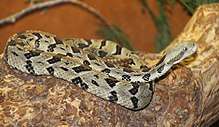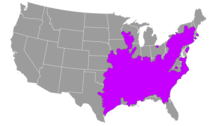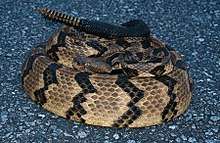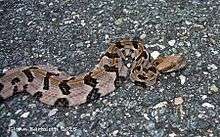Timber rattlesnake
The timber rattlesnake, canebrake rattlesnake or banded rattlesnake (Crotalus horridus),[4] is a species of venomous pit viper endemic to eastern North America. This is the only rattlesnake species in most of the populous northeastern United States and is second only to its cousins to the west, the prairie rattlesnake, as the most northerly distributed venomous snake in North America.[5][6] No subspecies are currently recognized.[7]
| Timber rattlesnake | |
|---|---|
 | |
| At Zollman Zoo | |
| Scientific classification | |
| Kingdom: | Animalia |
| Phylum: | Chordata |
| Class: | Reptilia |
| Order: | Squamata |
| Suborder: | Serpentes |
| Family: | Viperidae |
| Genus: | Crotalus |
| Species: | C. horridus |
| Binomial name | |
| Crotalus horridus | |
 | |
| Timber rattlesnake range[2] | |
| Synonyms[3] | |
| |


Taxonomy
The timber rattlesnake was one of the many reptile species originally described by Carl Linnaeus in the landmark 1758 10th edition of his Systema Naturae, and still bears its original name Crotalus horridus.[8]
The subspecies C. h. atricaudatus (Latreille in Sonnini and Latreille, 1802), often referred to as the canebrake rattlesnake,[4] is currently considered invalid.[9] Previously, it was recognized by Gloyd (1936) and Klauber (1936). Based on an analysis of geographic variation, Pisani et al. (1972) concluded no subspecies should be recognized. This was rejected by Conant (1975), but followed by Collins and Knight (1980). Brown and Ernst (1986) found evidence for retaining the two subspecies, but state it is not possible to tell them apart without having more information than usual, including adult size, color pattern, the number of dorsal scale rows and the number of ventral scales. Dundee and Rossman (1989) recognized C. h. atricaudatus, but others take a more neutral point of view.[10]
Description
Adults usually grow to total length of 91–152 cm (36–60 in).[5] It was found in Pennsylvania that the smallest size females that could produce viable eggs was 72.2 cm (28.4 in).[11] Most adult timber rattlesnakes found measure less than 100 to 115 cm (39 to 45 in) in total length and weigh on average between 500 and 1,500 g (1.1 and 3.3 lb), often being towards the lower end of that weight range.[12][13][14][15] The maximum reported total length is 189.2 cm (74.5 in) (Klauber, 1956). Holt (1924) mentions a large specimen caught in Montgomery County, Alabama, which had a total length of 159 cm (62.5 in) and weighed 2.5 kg (5.5 lb).[10] Large specimens can reportedly weigh as much as 4.5 kg (9.9 lb).[16]
The dorsal scales are keeled[17] and arranged in 21–26 scale rows at midbody (usually 25 rows in the southern part of its geographic range, and 23 rows in the northern part). The ventral scales number 158–177 in males and 163–183 in females. Males have 20–30 subcaudal scales, while females have 15–26. The rostral scale is normally a little higher than it is wide. In the internasal-prefrontal area there are 4–22 scales that include 2 large, triangular internasal scales that border the rostral, followed by 2 large, quadrangular prefrontal scales (anterior canthals) that may contact each other along the midline, or may be separated by many small scales. Between the supraocular and internasal, only a single canthal scale is present. There are 5–7 intersupraocular scales. The number of prefoveal scales varies between 2 and 8. Usually the first supralabial scale is in broad contact with the prenasal scale, although slightly to moderately separated along its posteroventral margin by the most anterior prefoveals.[10]
Dorsally, they have a pattern of dark brown or black crossbands on a yellowish brown or grayish background. The crossbands have irregular zig-zag edges, and may be V-shaped or M-shaped. Often a rust-colored vertebral stripe is present. Ventrally they are yellowish, uniform or marked with black.[18] Melanism is common, and some individuals are very dark, almost solid black.[19]
Distribution and habitat
Timber rattlesnakes can be found in the eastern United States from southern Minnesota and southern New Hampshire, south to east Texas and north Florida.[20] One hundred and fifteen rattlesnakes have been marked within Brown County State Park in Indiana, one of the only places where they can be found in the state.[21]
Its historic range includes southern Ontario and southern Quebec in Canada,[3] but in May 2001, the Canadian Species at Risk Act listed it as extirpated in Canada.[22] A Canadian government sponsored recovery strategy is currently under study to support the reintroducing of this predator of many pests to its former Canadian habitat.
Although several experts disagree, many were found in some of the thick forest areas of central and southeastern Iowa, mostly within the Mississippi, Skunk, Iowa, and Des Moines River valleys, in several places in these areas; bites from timber rattlesnakes have been widespread, especially in a localized area of Geode State Park, in southeastern Henry County, along Credit Island Park, in southern Scott County, and in the forested areas of southern Clinton County. The museum at Amana Colony, Iowa asserts that one founding family lost their firstborn, a daughter at the age of three, due to a rattlesnake bite she received while playing on a woodpile in the 19th century.
In Pennsylvania, it is not found west of Chestnut Ridge, which is in the Laurel Highlands, nor is it found in the southeastern corner of the state. Thus, its range does not include the areas of Philadelphia and Pittsburgh, the two largest cities in Pennsylvania.[5]
C. horridus is extirpated in Maine and Rhode Island and is almost extirpated in New Hampshire.
In Massachusetts, the snakes are active from mid-May to mid-October.[23] Early settlers were afraid of the snake, as its population was widespread throughout the state. Since that time their habitat has been reduced to the Blue Hills south of Boston, The Berkshires in Western Massachusetts as well as parts of the Connecticut River Valley, notably in the area of the Holyoke Range.[23] The snake is so rare in the state that it is rarely encountered by people and is considered endangered, making it illegal to harass, kill, collect, or possess.[24]
Generally, this species is found in deciduous forests in rugged terrain. During the summer, gravid (pregnant) females seem to prefer open, rocky ledges where the temperatures are higher, while males and nongravid females tend to spend more time in cooler, denser woodland with more closed forest canopy.[25]
Behavior
Female timber rattlers often bask in the sun before giving birth, in open rocky areas known as "basking knolls".[26]
During the winter, timber rattlesnakes brumate in dens, in limestone crevices, often together with copperheads and black rat snakes.[19]
Feeding
Their prey are mainly small mammals, but may include small birds, frogs, other small animals, including other snakes. Although capable of consuming other rattlesnakes, the most common snake they prey upon are garter snakes.[25] Like most rattlesnakes, timber rattlesnakes are known to utilize chemical cues to find sites to ambush their prey and will often strike their prey and track them until they can be consumed.[27][28] Timber rattlesnakes are known to use fallen logs as a waiting site for prey to pass by, giving them an elevated perch from which to effectively strike their prey, which is almost entirely terrestrial rather than arboreal (even arboreal prey such as squirrels tends to be caught when they come to the ground).[28][29] The primary foods by genera of timber rattlesnakes were as follows: Peromyscus (33.3%), Microtus (10.9%), Tamias (qv) (10.6%), Sylvilagus (10.4%), Sigmodon (5.3%) and Sciurus (4.2%). Based on examination of the snout-to-vent length, it was found that juvenile timber rattlesnakes differed slightly in dietary preferences from adult rattlesnakes, being more likely to consume smaller prey such as shrews (averaging 8 g (0.28 oz) and unable to attack subadult eastern cottontail rabbits (averaging 500–1,000 g (1.1–2.2 lb) but Peromyscus was the number one prey item for both young and adult rattlesnakes. Several birds, although always secondary to mammals, are also known to be hunted, mainly ground-dwelling species such as bobwhites, but also a surprising number of passerines.[30]
Venom
Potentially, this is one of North America's most dangerous snakes, due to its long fangs, impressive size, and high venom yield. This is to some degree offset by its relatively mild disposition[31] and long brumation period. Before striking, they often perform a good deal of preliminary rattling and feinting.[32] Cist (1845) described how he lived in western Pennsylvania for many years, and the species was quite common there, but in all that time, he heard of only a single death resulting from its bite.[4]
Considerable geographic and ontogenetic variation occurs regarding the toxicity of the venom, which can be said for many rattlesnake species. Four venom patterns have been described for this species: Type A is largely neurotoxic, and is found in various parts of the southern range. One effect of the toxin can be generalized myokymia.[33] Type B is hemorrhagic and proteolytic, and is found consistently in the north and in parts of the southeast. Type A + B is found in areas where the aforementioned types apparently intergrade in southwestern Arkansas and northern Louisiana. Type C venom has none of the above components and is relatively weak.[31]
The neurotoxic component of the type A venom is referred to as canebrake toxin, and is a phospholipase A2. It is analogous to the neurotoxins found in the venoms of several other rattlesnake species, and when present, contributes significantly to the overall toxicity. Other components found in the venom include a small basic peptide that works as a myotoxin, a fibrinogen-clotting enzyme that can produce defibrination syndrome, and a bradykinin-releasing enzyme.[31]
CroFab antivenom, while not specific for C. horridus, is used to treat envenomations from this species.[34]
Symbol
The timber rattlesnake was designated the state reptile of West Virginia in 2008.[35] That state's legislature praised "...a proud contribution by the eighth grade class at Romney Middle School, from West Virginia's oldest county, in West Virginia's oldest town, to have been instrumental in making the timber rattlesnake the state reptile..."[36]
This snake became a prominent symbol of American anger and resolve during the American Revolution due to its fearsome reputation. In the 18th century, European-trained doctors and scientists had little firsthand experience with or information on timber rattlesnakes,[37] and treatment of their bites was poorly effective. The motto Nemo me impune lacesset (with the verb in the future tense) appears above a Crotalus horridus on a 1778 $20 bill from Georgia as an early example of the colonial use of the coiled rattlesnake symbol, which later became famous on the Gadsden flag.
Conservation status
This species is classified as least concern on the IUCN Red List (assessed in 2007).[1] Species are listed as such due to their wide distribution, presumed large population, or because they are unlikely to be declining fast enough to qualify for listing in a more threatened category.[38]
The timber rattlesnake is listed as endangered in New Jersey, Vermont, Massachusetts[39] (along with the copperhead viper), Virginia, New Hampshire, Indiana,[40] and Ohio, and it is threatened in New York, Connecticut, Illinois, Minnesota, and Texas.
Timber rattlesnakes have already been extirpated in Maine and Rhode Island and only one population remains in New Hampshire. They are protected in many of the Appalachian states but their populations continue to decline.[41]
See also
References
- Hammerson GA (2007). Crotalus horridus. In: IUCN 2012. IUCN Red List of Threatened Species. Version 2012.2.
- U.S. Geological Survey (2017). "Timber Rattlesnake (Crotalus horridus) rTIRAx_CONUS_2001v1 Range Map". Gap Analysis Project. doi:10.5066/F7BR8R5P.
- McDiarmid RW, Campbell JA, Touré T (1999). Snake Species of the World: A Taxonomic and Geographic Reference, Volume 1. Washington, District of Columbia: Herpetologists' League. ISBN 1-893777-00-6 (series). ISBN 1-893777-01-4 (volume).
- Wright AH, Wright AA (1957). Handbook of Snakes of the United States and Canada. Ithaca and London: Comstock Publishing Associates, a division of Cornell University Press. (7th printing, 1985). 1,105 pp. (in two volumes). ISBN 0-8014-0463-0. (Crotalus horridus, pp. 956–966.)
- Conant R (1975). A Field Guide to Reptiles and Amphibians of Eastern and Central North America, Second Edition. (First published in 1958). Boston: Houghton Mifflin Company. xviii + 429 pp. + Plates 1-48. ISBN 0-395-19979-4 (hardcover), ISBN 0-395-19977-8 (paperback). (Crotalus horridus, pp. 233–235 + Plate 35 + Map 178.)
- Brown WS (1991). Female Reproductive Ecology in a Northern Population of the Timber Rattlesnake, Crotalus horridus ". Herpetologica 47 (1): 101-115.
- "Crotalus horridus ". Integrated Taxonomic Information System. Retrieved 8 February 2007.
- Linnaeus, Carl (1758). Systema Naturae per Regna Tria Naturae, Secundum Classes, Ordines, Genera, Species, cum Characteribus, Differentiis, Synonymis, Locis (in Latin). Vol. I (10th revised ed.). Holmiae: (Laurentii Salvii). p. 214. – via The Internet Archive.
- "Crotalus horridus atricaudatus ". Integrated Taxonomic Information System. Retrieved 27 September 2006.
- Campbell JA, Lamar WW (2004). The Venomous Reptiles of the Western Hemisphere (2 volumes). Comstock Publishing Associates. ISBN 0-8014-4141-2.CS1 maint: uses authors parameter (link)
- Galligan JH, Dunson WA (1979). "Biology and status of timber rattlesnake (Crotalus horridus) populations in Pennsylvania". Biological Conservation 15 (1): 13-58.
- Timber Rattlesnake (Crotalus horridus). Tpwd.state.tx.us. Retrieved on 2013-01-05.
- Fitch HS, Pisani GR, Greene HW, Echelle AF, Zerwekh M (2004). "A field study of the timber rattlesnake in Leavenworth County, Kansas". Journal of Kansas Herpetology 11: 18-24.
- Brown WS, Kéry M, Hines JE (2007). "Survival of timber rattlesnakes (Crotalus horridus) estimated by capture-recapture models in relation to age, sex, color morph, time, and birthplace". Copeia 2007 (3): 656-671.
- Clark RW (2006). "Fixed Videography to Study Predation Behavior of an Ambush Foraging Snake, Crotalus horridus ". Copeia 2006 (2): 181-187.
- ANIMAL BYTES – Canebrake Rattlesnake. Seaworld.org. Retrieved on 2013-01-05.
- Behler JL, King FW (1979). The Audubon Society Field Guide to North American Reptiles and Amphibians. New York: Alfred A. Knopf. 743 pp. ISBN 0-394-50824-6.CS1 maint: uses authors parameter (link) (Crotalus horridus, pp. 688-689 + Plates 619, 620, 653.)
- Boulenger GA (1896). Catalogue of the Snakes in the British Museum (Natural History), Volume III., Containing the ... Viperidæ. London: Trustees of the British Museum (Natural History). (Taylor and Francis, printers). xiv + 727 pp. + Plates I-XXV. (Crotalus horridus, pp. 578–580).
- Schmidt KP, Davis DD (1941). Field Book of Snakes of the United States and Canada. New York: G.P. Putnam's Sons. 365 pp. (Crotalus horridus horridus, pp. 301-302 + Plate 33; Crotalus horridus atricaudatus, p. 302).
- Conant R, Collins JT (1998). Reptiles and Amphibians of Eastern/Central North America. New York: Houghton Mifflin. ISBN 0-395-90452-8
- "The Timber Rattlesnake (Crotalus horridus) in Brown County State Park" (PDF). Indiana Department of Natural Resources. Retrieved August 8, 2017.
- Crotalus horridus Archived 2016-04-01 at the Wayback Machine at Species at Risk Public Registry. Accessed 23 June 2008.
- "Timber Rattlesnake: Crotalus horridus " (PDF). Massachusetts Division of Fisheries and Wildlife.
- "Timber Rattlesnake". Snakes of Massachusetts.
- Timber Rattlesnake Fact Sheet at NY State Dept. of Environmental Conservation. Accessed 8 February 2007.
- Furman, Jon (2007). Timber Rattlesnakes in Vermont and New York: Biology, History, and the Fate of an Endangered Species. Lebanon, New Hampshire: University Press of New England. p. 133. ISBN 978-1-58465-656-2.
- Clark RW (2004). "Timber rattlesnakes (Crotalus horridus) use chemical cues to select ambush sites". Journal of Chemical Ecology 30 (3): 607-617.
- Reinert HK, Cundall D, Bushar LM (1984). "Foraging behavior of the timber rattlesnake, Crotalus horridus ". Copeia 1984: 976-981.
- Platt SG, Hawkes AW, Rainwater TR (2001). "Diet of the canebrake rattlesnake (Crotalus horridus atricaudatus): An additional record and review". Texas Journal of Science 53 (2): 115-120.
- Clark RW (2002). '"Diet of the timber rattlesnake, Crotalus horridus ". Journal of Herpetology 36 (3): 494-499.
- Norris R (2004). "Venom Poisoning in North American Reptiles". In Campbell JA, Lamar WW (2004). The Venomous Reptiles of the Western Hemisphere. Ithaca and London: Comstock Publishing Associates. 870 pp., 1,500 plates. ISBN 0-8014-4141-2.
- US Navy (1991). Poisonous Snakes of the World. New York: US Government / Dover Publications Inc. 203 pp. ISBN 0-486-26629-X.
- "Snake Venoms and the Neuromuscular Junction: Spontaneous Activity". Medscape.com. 2004-08-16. Retrieved 2014-07-29.
- "MAVIN 2013-05-14, Crotalus horridus horridus ". Toxinfo.org. Retrieved 2014-07-29.
- "Senate concurrent resolution 28 (bill status 2008 regular session)". West Virginia Legislature. Retrieved February 22, 2011.
- "Senate concurrent resolution no. 28". 1st session of the 80th legislature. West Virginia Legislature. 2008. Retrieved February 25, 2011.
- Bryson, Bill (2004). A Short History of Nearly Everything. New York: Broadway Books. p. 81.
- 2001 Categories & Criteria (version 3.1) at the IUCN Red List. Accessed 13 September 2007.
- "Massachusetts List of Endangered, Threatened and Special Concern Speci". Mass.gov. Retrieved 2014-07-29.
- Indiana Legislative Services Agency (2011), "312 IAC 9-5-4: Endangered species of reptiles and amphibians", Indiana Administrative Code, retrieved 28 April 2012
- "Timber Rattlesnake". Orianne Society. Archived from the original on 26 October 2015. Retrieved 6 August 2015.
Further reading
- Brown CW, Ernst CH (1986). "A Study of Variation in Eastern Timber Rattlesnakes, Crotalus horridus Linnae (Serpentes, Viperidae)". Brimleyana 12: 57–74.
- Brown, William S. (July 1987). "Hidden Life of the Timber Rattler". National Geographic. Vol. 172 no. 1. pp. 128–138. ISSN 0027-9358. OCLC 643483454.
- Cist C (1845). The Cincinnati Miscellany or Antiquities of the West. vol. 1. Cincinnati. 272 pp.
- Collins JT, Knight JL (1980). "Crotalus horridus Linnaeus. Timber rattlesnake". Catalogue of American Amphibians and Reptiles. 253.1 – 253.2.
- Conant R, Bridges W (1939).What Snake Is That? A Field Guide to the Snakes of the United States East of the Rocky Mountains. (with 108 drawings by Edmond Malnate). New York and London: D. Appleton-Century Company. Frontispiece map + viii + 163 pp. + Plates A-C, 1-32. (Crotalus h. horridus, pp. 149-151 + Plate 31, figures 88A & 89; C. h. atricaudatus, pp. 151-152 + Plate 31, figures 88B & 88C).
- Gloyd HK (1936). "The cane-brake rattlesnake". Copeia 1935 (4): 175–178.
- Holt EG (1924). "Additional records for the Alabama herpetological catalogue". Copeia 1924: 100–101.
- Hubbs B, O'Connor B (2001). A Guide to Rattlesnakes and other Venomous Serpents of the United States. Tempe, Arizona: Tricolor Books. 129 pp. ISBN 978-0-9754641-3-7. (Crotalus horridus, pp. 68-71).
- Klauber LM (1936). "Key to the rattlesnakes with summary of characteristics". Trans. San Diego Soc. Nat. Hist. 8 (2): 185–176.
- Klauber LM (1956). Rattlesnakes: Their Habitats, Life Histories, and Influence on Mankind. 2 volumes. Berkeley: University of California Press. 1,476 pp.
- Linnaeus C (1758). Systema naturæ per regna tria naturæ, secundum classes, ordines, genera, species, cum characteribus, diferentiis, synonymis, locis. Tomus I. Editio Decima, Reformata [Volume I, Tenth Edition, Revised]. Stockholm: L. Salvius. (Crotalus horridus, new species, p. 214). (in Latin).
- McCoy CJ (1980). Identification Guide to Pennsylvania Snakes. (Design and illustrations by Michael Antonoplos). Pittsburgh, Pennsylvania: Carnegie Museum of Natural History. 12 pp. (Crotalus horridus, pp. 10-11).
- Morris PA (1948). Boy's Book of Snakes: How to Recognize and Understand Them. (A volume of the Humanizing Science Series, edited by Jaques Cattell). New York: Ronald Press. viii + 185 pp. (Crotalus h. horridus, pp. 94-97, 181; C. h. atricaudatus, pp. 98, 181).
- Netting MG, Richmond ND (editors) (1970). Pennsylvania Reptiles and Amphibians. Third Edition, Fifth Printing. (Photographs by Hal H. Harrison). Harrisburg, Pennsylvania: Pennsylvania Fish Commission. 24 pp. (Crotalus horridus, pp. 7-8 + front cover painting by Ned Smith).
- Pisani GR, Collins JT, Edwards SR (1972). "A re-evaluation of the subspecies of Crotalus horridus ". Trans. Kansas Acad. Sci. 75: 255–263.
- Powell R, Conant R, Collins JT (2016). Peterson Field Guide to Reptiles and Amphibians of Eastern and Central North America, Fourth Edition. Boston and New York: Houghton Mifflin Harcourt. xiv + 494 pp., 47 plates, 207 figures. ISBN 978-0-544-12997-9. (Crotalus horridus, pp. 440-441 + Plate 46 + Figure 168 on p. 356).
- Schmidt KP (1953). A Check List of North American Amphibians and Reptiles, Sixth Edition. Chicago: American Society of Ichthyologists and Herpetologists. 280 pp.
- Smith HM, Brodie ED Jr (1982). Reptiles of North America: A Guide to Field Identification. New York: Golden Press. 240 pp. ISBN 0-307-13666-3 (paperback), ISBN 0-307-47009-1 (hardcover). (Crotalus horridus, pp. 206-207).
External links
- Crotalus horridus at The IUCN Red List of Threatened Species.
- Crotalus horridus at the Reptarium.cz Reptile Database. Accessed 12 December 2007.
- Account of severe C. horridus envenomation at venomousreptiles.org. Accessed 12 December 2007.
- Snakes of Louisiana at Kingsnake.com. Accessed 7 August 2007.
- Timber rattlesnake at Reptiles and Amphibians of Iowa.
| Wikimedia Commons has media related to Crotalus horridus. |
| Wikispecies has information related to Timber rattlesnake |
